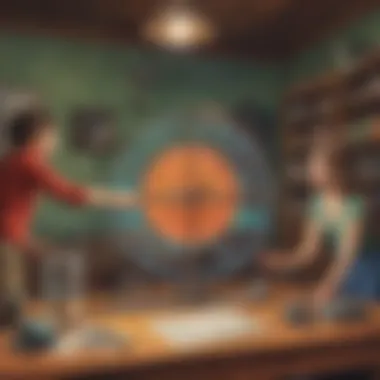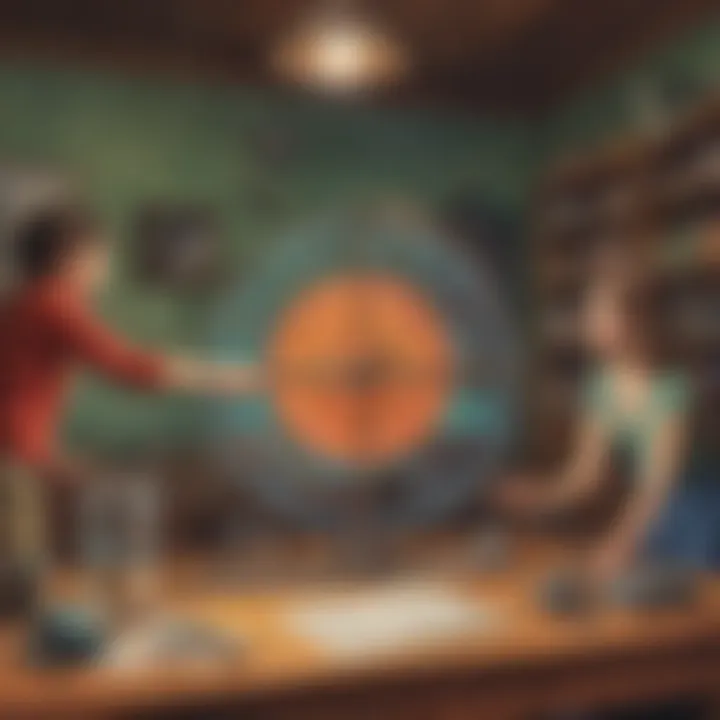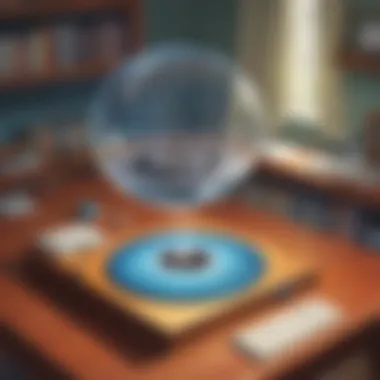Engage Young Minds with Fascinating Magnet Experiments for Kids 6-12


Science Fun Facts
Unravel the mysteries of magnetism with these intriguing science fun facts! Did you know that magnets have two poles, known as the North pole and the South pole? This fundamental property is what creates the attraction and repulsion between magnets, leading to various interesting phenomena. Moreover, magnets have been used for centuries in navigational compasses, aiding sailors in finding their way across the vast seas. Understanding these basic concepts sets the stage for the magnetic adventures ahead!
Discover the Wonders of Science
Embark on a journey to explore the wonders of magnetism through various scientific concepts. Watch educational videos and animations that demonstrate the principles of magnetism in an engaging and interactive manner. Discover real-life applications of magnets, from refrigerator doors to speakers, showcasing how this simple yet profound force shapes our daily lives. Delve into the practical side of magnetism and witness its omnipresence in the modern world.
Science Quiz Time
Challenge your knowledge with exciting science quizzes focusing on magnetism. Test your understanding with multiple-choice questions that cover the basics of magnetism and its applications. Engage in brain teasers and puzzles designed to enhance critical thinking skills while having fun with the enigmatic world of magnets. By participating in these quizzes, you can reinforce your knowledge and appreciate the captivating nature of magnetism.
Science Experiment Showcase
Prepare to conduct fun and engaging experiments that unravel the secrets of magnetism right before your eyes. Follow step-by-step instructions meticulously crafted to ensure a seamless experiment journey. Refer to the materials list to assemble all the necessary items for the experiments, guaranteeing a smooth and hassle-free experience. Prioritize safety by following the provided tips and precautions to make your magnetic exploration safe and enjoyable. Get ready to immerse yourself in the captivating realm of magnetism through hands-on experiments!
Introduction to Magnetism
In this article, we embark on a thrilling journey into the realm of magnetism, a fundamental force in the universe that captivates the imagination of young scientists. Understanding the principles of magnetism opens pathways to a world filled with discovery and innovation. The magnetic field surrounds us, influencing how objects interact with one another, from tiny iron filings to celestial bodies. Through engaging experiments, children between 6-12 years old can grasp the essence of magnetism, fostering a deep appreciation for the wonders of the natural world.
Understanding Magnetic Forces


The Basics of Magnetism
Delving into the basics of magnetism reveals the core principles that govern this magnetic phenomenon. Magnetic materials, such as iron, exhibit properties that align with the Earth's magnetic field, creating attraction or repulsion depending on polarity. This foundational knowledge serves as a cornerstone for comprehending more complex magnetic interactions. By exploring the basics of magnetism, young minds can unravel the mysteries of magnetic fields and their influence on objects around them. Hands-on experiments unveil the invisible forces at play, sparking curiosity and logical thinking.
Magnetic Poles and Interactions
Investigating magnetic poles sheds light on how magnets behave in various scenarios. The concept of magnetic poles, north and south, guides the interaction between magnets, determining attraction or repulsion. Understanding these interactions aids in predicting the behavior of magnets, laying the groundwork for creating innovative magnetic-based devices. Through hands-on activities that demonstrate magnetic pole interactions, children can grasp the significance of polarity and its role in shaping the world of magnetism. Exploring magnetic poles fosters an intuitive understanding of magnetic phenomena, paving the way for advanced experiments and scientific inquiry.
Simple Magnet Experiments
In this enlightening segment of the article, we delve into the significance of Simple Magnet Experiments within the context of igniting curiosity and enhancing learning for young science enthusiasts. These experiments play a crucial role in demonstrating the fundamental principles of magnetism in a hands-on and engaging manner, allowing children to explore scientific concepts in a practical and enjoyable way. By conducting Simple Magnet Experiments, kids can grasp the basics of magnetic forces, poles, and interactions in a tangible way, setting a strong foundation for further exploration in the realm of magnetism.
Exploring Magnetic Fields
Creating a magnetic field with iron filings
Venturing into the realm of magnetic fields by creating a magnetic field with iron filings provides a captivating visual representation of the invisible forces at play. This experiment allows children to witness the alignment of iron filings along the magnetic field lines, providing a clear indication of the magnetic field's direction and strength. By observing the patterns formed by the iron filings, young learners can better comprehend the spatial distribution of magnetic forces and gain insight into the concept of magnetic flux. The hands-on nature of this experiment makes it an ideal choice for this article, as it enables children to actively engage with magnetic phenomena and deepen their understanding through direct observation.
Detecting magnetic fields with a compass
Exploring magnetic fields through the use of a compass offers a practical and interactive way for children to detect and visualize magnetic forces. By observing the deflection of the compass needle in the presence of a magnet, young learners can identify the magnetic field's direction and intensity, providing them with a tangible experience of how magnets interact with the Earth's magnetic field. This experiment not only highlights the concept of magnetic poles and interactions but also instills a sense of wonder and discovery as children witness the influence of magnetism on a familiar navigational tool. The simplicity and effectiveness of using a compass to detect magnetic fields make it a valuable addition to this article, facilitating a hands-on exploration of magnetic principles.
Levitating Magnets


Making a pencil 'levitate' using a magnet
Engaging in the whimsical act of making a pencil 'levitate' using a magnet introduces children to the intriguing phenomenon of magnetic levitation. By carefully positioning a magnet to suspend a pencil in mid-air, young experimenters can observe the balance between magnetic attraction and gravitational force, creating a visual spectacle that defies conventional expectations. This experiment not only showcases the concept of magnetic levitation but also encourages children to think creatively and explore the unconventional applications of magnetism. The allure of seeing an everyday object float seemingly by magic captures the imagination of young learners, making it a delightful and thought-provoking choice for inclusion in this article.
Magnetic Attraction and Repulsion
Testing attraction and repulsion with different magnets
Diving into the realm of magnetic attraction and repulsion through experiments with different magnets allows children to investigate how magnets interact with varying strengths and polarities. By observing the behavior of magnets when placed in close proximity, young learners can discern between attractive and repulsive forces, gaining insights into the principles of magnetic polarity. This experiment not only fosters a hands-on exploration of magnetic interactions but also cultivates critical thinking skills as children analyze and compare the behaviors of different magnet types. The interactive nature of testing attraction and repulsion with magnets adds a layer of excitement and discovery to the learning experience, making it a valuable and engaging component of this article.
Creating a floating magnet experiment
Embarking on the creation of a floating magnet experiment opens up new avenues for exploring the dynamic balance of forces in magnetism. By suspending a magnet in a stable floating position, children can witness the intricate interplay between magnetic forces and gravitational pull, prompting them to ponder the equilibrium achieved in this unique setup. This experiment not only demonstrates the concept of magnetic levitation but also prompts young learners to consider the delicate forces at play in everyday interactions. The novelty and intrigue of observing a magnet float in mid-air captivate children's curiosity and spark a deeper interest in the mysteries of magnetism, making it an intriguing and insightful addition to the repertoire of experiments in this article.
Exploring Electromagnetism
Building a simple electromagnet
Venturing into the realm of electromagnetism through the construction of a simple electromagnet offers children a hands-on introduction to the fusion of electricity and magnetism. By winding a coil of wire around a ferromagnetic core and passing an electric current through it, young experimenters can witness the transformation of the core into a magnet, capable of attracting magnetic materials. This experiment not only elucidates the fundamental principles of electromagnetism but also highlights the direct relationship between electricity and magnetism, providing a concrete example of how electrical dynamics can produce magnetic effects. The accessibility and educational value of building a simple electromagnet make it a worthwhile and illuminating choice for inclusion in this article.
Using an electromagnet to pick up paper clips


Exploring the practical applications of electromagnetism by using an electromagnet to pick up paper clips demonstrates the utility and versatility of this magnetic technology. By activating the electromagnet with an electric current, children can observe its magnetic field attracting nearby ferromagnetic objects, showcasing the gripping power of electromagnetism in everyday scenarios. This experiment not only underscores the practical implications of electromagnetism but also encourages children to consider the numerous ways in which magnetic technologies enhance modern life. The hands-on experience of using an electromagnet to pick up paper clips provides young learners with a clear demonstration of electromagnetism's functionality and sparks curiosity about its diverse applications, making it an engaging and informative component of this article.
Advanced Magnet Experiments
In the realm of magnetism exploration, delving into Advanced Magnet Experiments opens a gateway to intricate scientific discoveries and hands-on learning experiences. These experiments serve as a crucial element in providing a deeper understanding of magnetic forces for young minds. By moving beyond the basics, children aged 6-12 can grasp complex concepts and witness magnetic phenomena in action. The benefits of Advanced Magnet Experiments lie in their ability to nurture critical thinking skills, fostering curiosity and a passion for scientific inquiry. Through these experiments, children develop a stronger connection to the scientific world, inspiring them to pursue further exploration. Considering the interactive nature of Advanced Magnet Experiments, children can actively engage with the principles of magnetism, enhancing their cognitive abilities and practical knowledge.
Building a Magnetic Maze
Creating a maze with magnetic forces
Within the realm of Advanced Magnet Experiments, the concept of creating a maze with magnetic forces stands out as a captivating endeavor. This specific aspect adds a layer of complexity to the exploration of magnetism, challenging young scientists to design pathways guided by magnetic attraction and repulsion. The key characteristic of creating a maze with magnetic forces is its ability to merge creativity with scientific principles, offering a hands-on experience that sparks innovation and problem-solving skills. This choice is beneficial for the article as it introduces children to the idea of manipulating magnetic fields in a fun and interactive manner. The unique feature of creating a maze with magnetic forces lies in its multi-sensory appeal, combining visual, tactile, and cognitive stimulation to create an immersive educational experience. While this experiment introduces challenges in designing and executing magnetic mazes, its advantages in promoting spatial reasoning and magnetic theory comprehension make it a valuable inclusion in the article.
Magnetic Polarity Exploration
Testing magnetic poles on various materials
Exploring magnetic polarity by testing magnetic poles on various materials serves as a fundamental activity in the Advanced Magnet Experiments section. This specific aspect contributes significantly to the overarching goal of developing a comprehensive understanding of magnetic forces. By investigating how different materials interact with magnetic poles, children can witness firsthand the effects of attraction and repulsion. The key characteristic of this experiment lies in its ability to demonstrate the magnetic properties of diverse substances, highlighting the variation in their responses to magnetic fields. This choice is popular for the article as it provides a hands-on approach to discerning polarity differences, engaging young learners in the exploration of magnetism's nuances. The unique feature of testing magnetic poles on various materials is its practical application in real-world scenarios, allowing children to appreciate the relevance of magnetic principles in everyday life. While presenting challenges in identifying materials' magnetic behaviors, the advantages of this experiment in promoting critical observation skills and scientific reasoning reinforce its importance within the article.
Conclusion:
Implications of Magnetism Experiments:
Encouraging Scientific Curiosity and Exploration
An integral aspect of these magnetism experiments is their ability to inspire scientific curiosity and promote a sense of exploration among young individuals. By engaging in activities that prompt questions and spark inquisitiveness, children learn to think critically and analytically. Encouraging scientific curiosity lays the groundwork for lifelong learning and nurtures a spirit of inquiry that is invaluable in academic and personal growth. The emphasis on exploration in this article underscores the significance of fostering a mindset that values investigation and discovery, shaping young learners into future problem-solvers and innovators.
Fostering a Love for Hands-On Learning
Another key attribute of the magnet experiments presented here is their focus on hands-on learning, which plays a vital role in the educational journey of children. By actively handling materials, conducting experiments, and observing outcomes, kids develop a deeper understanding of scientific concepts and principles. This tactile approach not only enhances comprehension but also instills a love for experimentation and discovery. Hands-on learning promotes retention of information, improves critical thinking skills, and cultivates a sense of accomplishment when young learners see the direct results of their actions. The emphasis on hands-on experiences in this article aims to ignite a passion for learning that extends beyond the confines of traditional education, empowering children to engage with the world around them in a meaningful and enriching manner.







